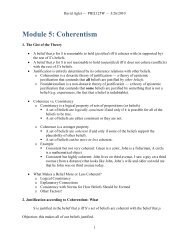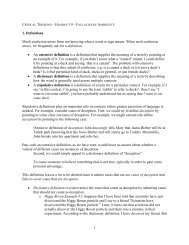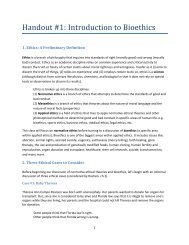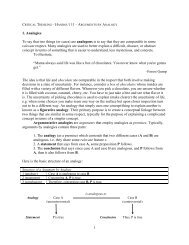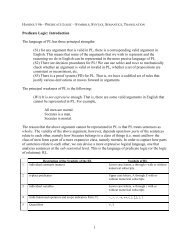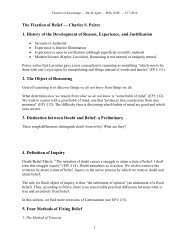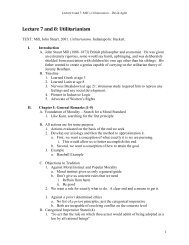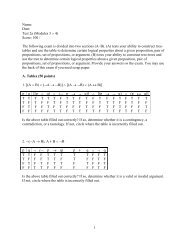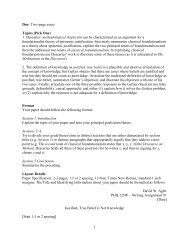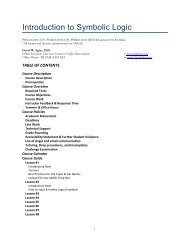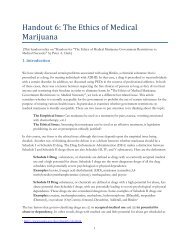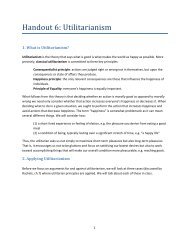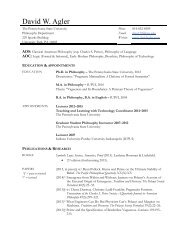A. Valuating wffs at a world in a Model: Consider the following model <strong>and</strong> determine whether ornot the following propositions are true or false:M = whereW ={w 1 , w 2 },R ={, }, <strong>and</strong>I(P, w 1 )=T, I(P, w 2 )=F, I(S, w 1 )=T, I(S, w 2 )=T1. v M (¬P, w 1 )2. v M (P∧S, w 2 )3. v M (P→S, w 1 )4. v M (◊P, w 1 )5. v M (◊P, w 2 )6. v M (□S, w 1 )7. v M (□S, w 2 )8. v M (◊¬P, w 1 )9. v M (¬□P, w 1 )10. v M (◊□P, w 1 )B. Testing Your Underst<strong>and</strong>ing: Using the above model, what additional information is neededto determine the truth value of the following proposition: ◊¬P. What does this say about modallogic semantics <strong>and</strong> the nature of possibility <strong>and</strong> necessity?10
9.5 <strong>Modal</strong> Systems: S, D, T, B, S4, S5In the previous section, a generic definition of a model was provided along with a description ofhow to assign truth values to wffs given a fleshed-out model. In this section, we consider thesemantics for various modal systems. There are several obstacles for constructing a semantics forML. First, as the modal operators ◊ <strong>and</strong> □ are not truth-functional, it is not possible to representthe semantics of ML using truth tables or truth-tree diagrams. Recall that a propositionaloperator is truth-functional if <strong>and</strong> only if the truth value of the complex proposition P, composedof propositions R <strong>and</strong> S, is determined entirely by the truth values of R <strong>and</strong> S. That is, since thepropositional operator “∧” is truth-functional, we can determine the truth-value of “A∧B” giventhe truth values of “A” <strong>and</strong> “B”. In contrast, “possibly” <strong>and</strong> “necessarily” (<strong>and</strong> theircorresponding operators) are not truth-functional. That is, the truth values of “possibly P” <strong>and</strong>“necessarily P” are not determined by the truth value of P. If “possibly’ <strong>and</strong> “necessarily” weretruth-functional, then it would be possible to determine the truth value of sentences like “It ispossible that John is planning a picnic” from the truth value of “John is planning a picnic.”Unfortunately, this cannot be determined for if we suppose that John is not planning a picnic, thetruth or falsity of “It is possible that John is planning a picnic” will depend upon additionalfactors we don’t have access to: is John even alive to do the planning? is John capable ofplanning a picnic?The second obstacle is more problematic, philosophical, <strong>and</strong> irksome. In propositional<strong>and</strong> predicate logic, barring a few isolated cases, there is a strong consensus about the formulathat should count as tautologies in PL <strong>and</strong> RL. Proposition of the form “P∨¬P”, “P→P”,“P→(Q→P)” are true independent of the specific propositions we substitute for “P” <strong>and</strong> “Q”.For a language involving ◊P <strong>and</strong> □P, what propositions should count as tautologies <strong>and</strong> whatarguments should count as valid? While there are some formula that clearly should count astautologies, e.g. □(P∨¬P) <strong>and</strong> ¬◊(P∧¬P), there are several formula where it is uncertainwhether they should count as tautologies, e.g., ◊□P→P.Rather than solving this philosophical problem, we sidestep it by developing a variety ofdifferent modal systems. These systems are named K, D, T, B, S4, <strong>and</strong> S5. While each modalsystem shares a common set of symbols <strong>and</strong> syntax, <strong>and</strong> uses the generic notion of a model, eachof these systems is distinguished by their semantics. Specifically, K, D, T, B, S4, <strong>and</strong> S5 aredistinguished according to what formal properties belong to the accessibility relation R. Theseformal properties (<strong>and</strong> their corresponding systems) are as follows:<strong>Modal</strong> SystemKDTBS4S5Property of Accessibility RelationNoneSerialReflexiveReflexive <strong>and</strong> SymmetricReflexive <strong>and</strong> TransitiveReflexive, Symmetric, <strong>and</strong> TransitiveThus, in system S4 (i.e., in a S4-model), the accessibility relation R is both reflexive <strong>and</strong>transitive. That is, for any set of worlds W in a S4-model, every member of W accesses itself <strong>and</strong>11



